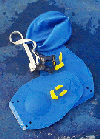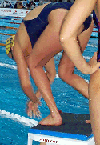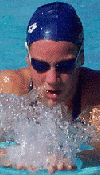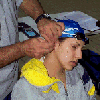|
LACTATE TESTING FOR SWIM COACHES - HOW TO USE IT
Testing gives you a snapshot of the current status of the athlete, either in terms of the total performance characteristics or a single, isolated parameter.
|

|
Total Performance Characteristics (TPC) These are "baseline" information tests or comparisons with previous tests to ascertain the intervening training effect. (To confuse you, TPC's are sometimes called Complex Performance Diagnostics, or CPD.
Isolated Parameters These are usually accessed by "spot" checks during normal training sets.
Both these aspects of testing can be used as educational tools to help the athlete better understand the training process.
|
The Lactate Race Model, outlined on the "why test" page, shows the order in which the various energy-replacement mechanisms operate during a race. The tests giving information corresponding to each race section are as follows :
|
|
Start and early meters : Alactic energy replacement. |
TPC - no available test. IP - short (10-15m), maximum speed, explosive sprints. |
|
Mid-race, part 1 : Aerobic energy replacement |
TPC - step test, IP - Standard Test Set, or Timed-distance Swim |
|
Mid-race, part 2 : Anaerobic energy replacement |
TPC - step test IP - Standard Test Set, or Lactate Production sets. |
| End part : Anaerobic energy replacement |
TPC - step test IP - Lactate Tolerance set. |
| Post-race recovery : Aerobic energy replacement (Lactate clearance - repayment of oxygen debt) |
TPC - step test (passive recovery or swim-down) IP - no available test. |
|
THE TESTS
MAXIMUM SPEED SPRINT - 1 x 15m
In short, high-intensity sprints the energy use is alactic - literally, without lactic acid. If you design a high-intensity test where you expect little lactic acid production, then there should be little lactate appearing in the blood. If a low value is returned, this confirms that the energy used was alactic.
Alactic energy replacement occurs only for a few seconds so test efforts must be very short. Sprints of no more than 15m are recommended. Although training sets for alactic development can include multiple sprints, the test should be restricted to one swim only. Like chances to make a first impression, you only get one start to a race. A push, 15m sprint, timed from feet leaving, to head at 15m, is the most consistent way of administering this test.
Initially, blood samples should be taken during the first, second and third minutes after the swim. As the lactate removal characteristics of the swimmer become known over time, you can eventually cut back to two, or even one, sample. The highest value is the significant one.
|

|

|
STEP TEST - 5 x 200m
This series of swims, at systematically increasing speeds, ("stepped" efforts), is, without doubt, the most valuable one available to any swimming coach. If performed and interpreted correctly, it gives information about almost every aspect of the swimmer's performance.
Any distance, or combination of distances, can be used but most programs have
settled on a series of 200m swims, usually five but it can be four, six or
seven. The important factor is to obtain data across the full range of speeds.
The more steps, the better the data; the less steps, the happier the swimmer.
The DDR, where the step test was first developed, used 8 x 100m, 8 x 200m or 5
x 400m, depending on the individual's main race distance. The 400 tests used
four steps and the 100 and 200 tests used five, as follows :
|
|
400m SWIMMERS : 5 X 400m (Freestyle/IM) |
|
STEP |
REP No. |
INTENSITY MAXIMUM PLUS (seconds) |
APPROX. REST (mins) |
No. of BLOOD SAMPLES |
|
1 |
1 |
24-27 |
1 |
1 |
|
|
2 |
24-27 |
3 |
2 |
|
2 |
3 |
16-18 |
5 |
2 |
|
3 |
4 |
8-9 |
20 |
3 |
|
4 |
5 |
Max |
|
3 |
|
|
|
Swim-down |
|
1 |
|
|
|
100m SWIMMERS : 8 X 100m MAIN STROKE |
|
STEP |
REP No. |
INTENSITY MAXIMUM PLUS (seconds) |
APPROX. REST (mins) |
No. of BLOOD SAMPLES |
|
1 |
1 |
12-16 |
1 |
1 |
|
|
2 |
12-16 |
1 |
1 |
|
|
3 |
12-16 |
3 |
2 |
|
2 |
4 |
9-12 |
1 |
1 |
|
|
5 |
9-12 |
3 |
2 |
|
3 |
6 |
6-8 |
5 |
3 |
|
4 |
7 |
3-4 |
20 |
3 |
|
5 |
8 |
Max |
|
3 |
|
|
|
Swim-down |
|
1 |
| The 200m test uses the same format as the 100m test except the Intensities
are halfway between those for the 400m test and the 100m test. For example,
the first step should use a 200m time that is 18-21 seconds slower than the
best time. |
|
| |
CURRENT PRACTICE
Nowadays, most programs would do one swim at each step; it saves time, money
and body-piercing! It makes sense to use the minimum number of swims and blood
samples which will give you the information you require. Providing the test is
performed correctly and consistent protocols are used from test to test, one
swim at each step is adequate. Proper performance includes even-pace swimming,
controlled application of effort and evenly spaced speed increases, across the
range, from step one to maximum. It is not a disaster if the swimmer starts
too slowly, but it could be a problem if they start too fast, either by uneven
splitting, where the lactate will not reflect the average speed, or by step
one being too high an intensity, in which case there will be no information
about the lower aerobic levels. This can also cause the swimmer to tire, so
that they can't complete all the steps correctly, or show a very tight speed
range, which makes it difficult to interpret the data.
STANDARD TEST SET (STS)
Coaches have favourite sets which they use regularly to assess the current status of their swimmers. These will range from 6 x 1000m, through 10 x 200m, to 8 x 50m. Whatever the distance and repetitions, if the same set is used regularly, then valuable information is gained. If the set is long and, therefore low intensity (it can still be hard effort), then the information is concerned with aerobic metabolism. If the set is short and high intensity (8 x 50m), then it is anaerobic in nature. The qualities indicated from the results of the chosen set should reflect the targeted qualities of the race model.
|
TIMED-DISTANCE SWIMS
|
| |
T30 - Timed 30-minute swim
The T30 has become a very popular swim for training and testing purposes. Popular with coaches, that is! If swum at an honest, maximum effort, even-paced, it gives results which indicate the anaerobic threshold speed and lactate level for most swimmers.
|

|
T2000 - 2000m Time-trial
There has been a general move towards T2000 in recent years because it is easier to administer. Swimmers don't have to stop in the middle of the pool. It is shorter than a T30 for most swimmers, and the results, in terms of measuring changes in aerobic metabolism, are just as valid. For many swimmers the speed and, therefore lactate, will be slightly higher than anaerobic threshold values but, so what? The results will indicate changes in aerobic capabilities excellently because the energy replacement will have been predominantly aerobic.
|
| |
LACTATE PRODUCTION SETS
The ability to produce large quantities of lactic acid quickly is very important in swimming fastest. Some swimmers seem to "get stuck" at certain lactic acid levels and can't break through to the higher values. This can be a real problem when they are trying to "lift" themselves to higher performance efforts. A set such as 8 x 50m with sixty seconds rest will enable the swimmer to repeat fast swimming enough to force the muscles to produce high levels of lactic acid. If you changed the set to, say, 3 x 4 x 50m with the three rounds descended from, say, 90% to 100%, with blood samples taken for every swim, you could easily identify any "sticking points" in the lactate range.
LACTATE TOLERANCE SET
Lactate tolerance is about time, not effort.
Many swimmers can produce large quantities of lactic acid, but having the ability to continue swimming, under control, at maximum effort is what tolerating lactic acid is all about. The test sets for tolerance, therefore, need to be designed around the time factor at high lactic acid levels, rather than the high levels themselves. For 100m swimmers, a set of 4 x 75m, for example, will ensure that a high speed can be attained, therefore causing large amounts of lactic acid to be produced and, because the effort is repeated, the amount of lactic acid in the muscle will rise, causing problems for the swimmer's coordination and comfort. The rest interval must be long enough for the high speed to be repeated, but short enough to ensure that the muscle stays acidic. One and a half, or two minutes should be ok. By the fourth repeat the swimmer should definitely be swimming the whole 75m with higher amounts of lactic acid than they will encounter on the last 75m of a 100m race.!
If the swimmer cannot get themselves up for the very fast efforts, then the time factor should be extended to, say, 125m swims. The goal on these sets is always concerned with the time spent at high lactic acid levels rather than the production of lactic acid.
POST-RACE or POST-TEST RECOVERY
Lactate clearance
The appearance of lactate in the blood indicates the clearance of lactic acid from the muscle. The faster this occurs, the faster the muscle can get on with more work! Slow or delayed lactate clearance is fast becoming the recognized indicator of over-training and the degree of clearance over time can be used to prescribe effective swim-down protocols.
Lactic acid is removed from the muscles into the blood during exercise but, at race intensities, it cannot be removed at the same speed it is being produced. At the end of the race there is, therefore, a large amount of lactic acid retained in the muscle cells. This is removed over time after the race and the removal rate can be tracked by taking sequential blood samples. It is generally accepted that the blood lactate accurately indicates the muscle lactic acid, but the removal is neither instantaneous nor linear.
|

|
As a general rule the faster the swim and/or the more sprint-oriented the swimmer, the longer time will elapse before the lactic acid removal rate reaches full effectiveness and the lactate values peak. So a distance swimmer performing a sub-maximal effort may peak within one or two minutes after the swim; a sprinter may take ten or more minutes after a maximum effort race. The highest, or peak, value is the significant one as far as the race is concerned but the rate of removal is significant as far as recovery is concerned, so you may need to continue sampling, say every two minutes, for twenty or more minutes to track clearance rates effectively.
|
FEAR OF BLOOD
If proper blood-handling techniques are used, there is nothing to fear about
sampling.
The swimmer should be given a full explanation of the purpose and the
procedure of the test and they should formally give their "informed
consent". Experienced people can puncture the swimer's ear-lobe so
efficiently that sometimes the swimmer is unaware that the puncture has
happened. Repeated sampling from the same puncture site is not a problem,
unlike using the finger-tip, where a fresh puncture has to be made for each
sample, often resulting in sore fingers.
The amount of blood needed, when using the Accusport Portable Lactate
Analyzer, is very small - about 20 micro-liters, which is one nice-sized drop.
The ear-lobe is gently squeezed, or "milked" and the blood drop automatically
transferred into a small glass tube, merely by holding the tube to the
blood. The hands need never come into contact with the blood, but it is
always advisable for the sampler to wear latex gloves.
"Measure everything that can be measured"
You can design a test to give information about any quality you wish. Whatever test protocol you decide, it is imperative that you stick to it, if you are to be able to use the results effectively. On any test, it is good practice to always check stroke-count, stroke-rate, HR, lactate and time so that the cause of any changes can attributed accurately.
|
| |
|

|
|
Why |
How |
Interpret |
Lactate.com
Home | Swimming
Core | Glossary
Questions? Please email info at lactate dot com
Published originnally March 29, 1998. All contents © Sports Resource
Group, Inc.
|

|

|

|

|

|







